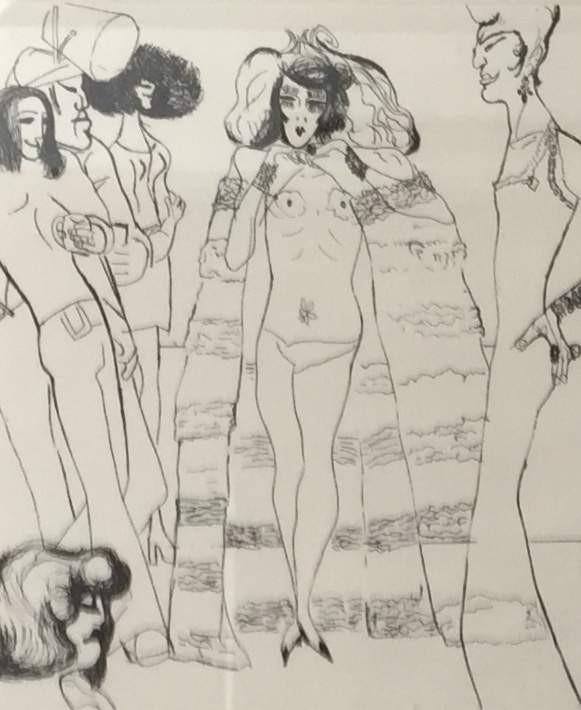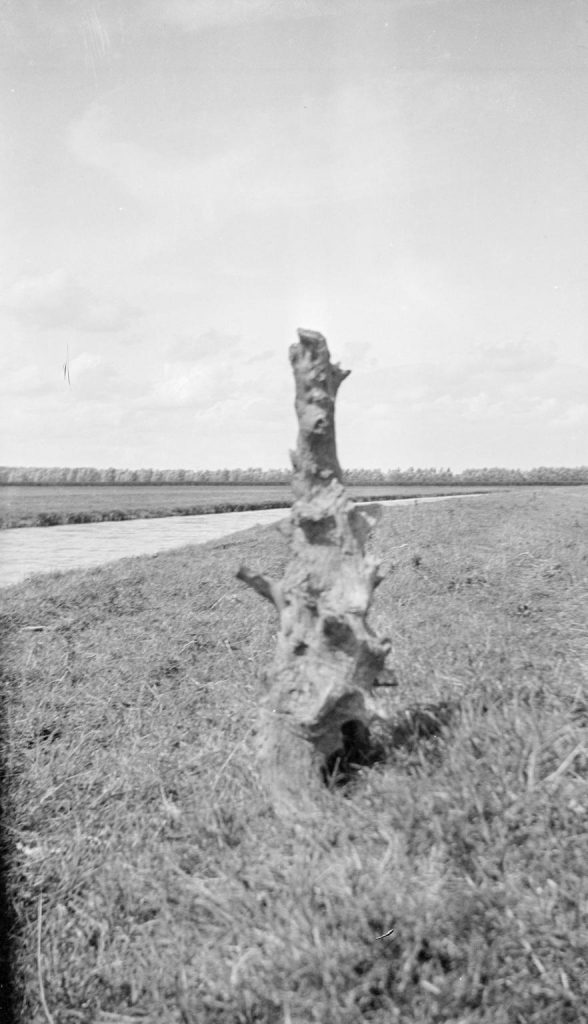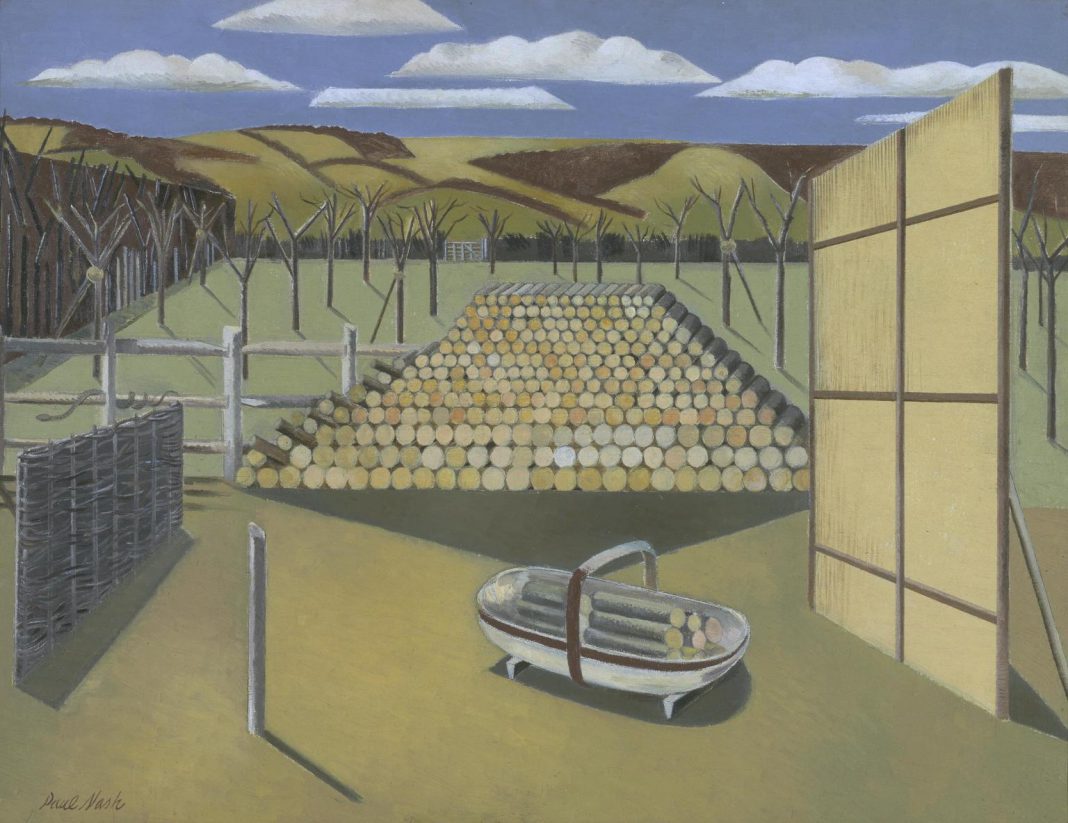Two twentieth-century artists with links to Rye, Paul Nash and Edward Burra, are part of a major new exhibition exploring British surrealism at the Dulwich Picture Gallery, in South London, until May 17.
The big names of surrealism – Dali, Magritte, Ernst and Kahlo – were from mainland Europe or beyond, but this new exhibition explores home-grown surrealism and traces its heritage back to figures such as William Blake and Edward Lear.
Both Edward Burra (1905-1976) and Paul Nash (1889-1946) lived and painted in and around Rye in the years after the first world war. Nash, however, is probably best known for his war art, in particular his paintings of the war-torn “no man’s land” of the first world war. Burra, meanwhile, is most famous for his images of Paris café life and the jazz scene in New York’s Harlem in the 1930s – and one of his works is shown below.
Nash first came to the Rye area in the 1920s to recover from nervous exhaustion following his wartime experiences. He lived in Dymchurch and Iden before moving to New House in the town’s East Street in 1931, now marked with a blue plaque.

As well helping him recover from severe depression (or what we might now think of as post traumatic stress disorder), he found “much inspiring material for work” in the local landscape. Here, he created the kind of landscape painting for which he became known; unearthing a beauty and mysticism in the English countryside while also evoking a powerful sense of place.
This can be seen in his 1929 painting “Landscape at Iden” (above) which depicts the view looking across Rother Valley from his home at Oxenbridge Cottage in Iden. There is some lovely regional detail: a Sussex trug in the foreground, rows of fruit trees typical of Kentish orchards and, to the right of the canvas, the type of screen used locally to protect fruit from frost and wind.
But there are also subtle surrealist touches. There is something strange about the way the trees are arranged in rigidly straight lines; the sawn-up logs in the foreground are stacked in a trapezoid shape that is almost abstract; on the left a snake coils itself around the fence rails.
As a result, the whole composition has a dream-like and uncanny quality to it; dreams and the unconscious being important to surrealism. It is interesting to see how elements from this Iden-inspired canvas, such as the fruit screens, reappear in his later, more fully surrealist, paintings such as “Landscape from a Dream” of 1936-38.
As well as painting the local landscape, Nash took photographs with a pocket Kodak camera given to him by his wife Margaret after they visited America in 1931. Nash was an early practitioner of surrealist photography, something clearly seen in the images he took of Romney Marsh, a landscape that somehow particularly lends itself to surrealism.
His 1934 photograph “Marsh Personage’, for instance, is of a weathered and gnarled tree stump he found on the banks of the River Rother. It suggests a truncated human body – hence the name. Nash photographed it in different settings and it reappears in more fully surrealist form in his later painting of 1936 “Swanage”.

Several surrealist methods are at play here such as a strange juxtapositions of unrelated objects and the use of found objects (or objets trouvés). “Marsh Personage” was shown in the New Burlington Galleries International Surrealist Exhibition of 1936 which also showcased Dali, Man Ray and Picasso.
Unlike Nash, Edward Burra was born into a local Rye family and grew up in Springfield, a large house in eleven acres of garden on the road heading out of town towards Peasmarsh. The Burras were important figures in the local community; a stained-glassed window in St Mary’s Church is dedicated to the memory of his grandfather Henry Burra who was the town’s mayor, and Edward Burra’s father had been chairman of East Sussex County Council.
Edward Burra, however, had mixed feelings about the town describing it as “ducky little Tinkerbell towne … like an itsy bitsy morgue” feelings that can perhaps be attributed to his never having been able to completely move away. From childhood he had suffered from chronic rheumatoid arthritis and a rare blood disease and, despite going to art college and travelling widely, he never truly left home.
Another side effect of his ill-health was that he was limited to painting almost exclusively in watercolours. Oil paints were difficult for his arthritic hands to handle.
Edward Burra is known for making the ordinary and everyday look strange, even sinister. This is clearly illustrated in three locally-inspired paintings from different periods of his life. “Cabbages, Springfield, Rye” (c.1937) depicts the gently rolling Sussex Weald seen from the Burra family home just north of the town.
However, this is not a conventional landscape painting: the trees bend and quiver as though about to spring to life, the branches look like fingers and a tree trunk seems caught in the process of transforming into a woman’s body.
Four years later, Burra’s 1941 painting “Rye Soldiers” records how the town became a centre for military activity during the second world war, but in a most unsettling manner. The soldier’s faces are painted in livid colours with huge bird-like beaks and bodies resembling armour, reminiscent of figures from a Hieronymus Bosch painting. The horrors of war are evoked in a very surreal way.
Finally, “The Churchyard Rye” (1959-61) uses Rye’s Church Square as its setting. On the bottom left of the canvas is a female figure dressed in black walking along the cobbled street that borders the church wall. She could be nothing more than an elderly local woman except that a figure walking beside her is such a sharp contrast.
This second, ghostly figure could possibly be naked – the contours of the body are clear to see – yet they are almost lost in the greyness of the wall. Sitting on the grass in the churchyard are two more figures, painted in an inky black with strangely misshapen outlines. In the foreground on the right are a disorderly row of glowing white tombstones lined up in a queue, as though trying to escape the confines of the churchyard. The setting is definitely Rye, but Rye through a surrealist’s eye.
Rye and its environs might seem an unlikely outpost of surrealism. It is a place more usually associated with traditional, old-world charm rather the avant-garde and the experimental: which makes it even more fascinating to speculate on the part, however small, that the area played in inspiring two leading figures of British surrealism.
Though not featured in the Dulwich Picture Gallery exhibition, the works of art by Nash and Burra mentioned here can be viewed online.
[Editor’s note: Nash’s “Landscape at Iden” and “Marsh Personage” and Burra’s “Soldiers at Rye” can be found on the Tate website (tate.org.uk) and Burra’s “Cabbages at Springfield, Rye” and “The Churchyard, Rye” can be found using Google.]
Image Credits: © Tate, Photo © Tate, CC-BY-NC-ND 3.0 (Unported) CC-BY-NC-ND 3.0 (Unported) , Rye Art Gallery .



